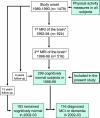Physical activity predicts gray matter volume in late adulthood: the Cardiovascular Health Study
- PMID: 20944075
- PMCID: PMC3039208
- DOI: 10.1212/WNL.0b013e3181f88359
Physical activity predicts gray matter volume in late adulthood: the Cardiovascular Health Study
Abstract
Objectives: Physical activity (PA) has been hypothesized to spare gray matter volume in late adulthood, but longitudinal data testing an association has been lacking. Here we tested whether PA would be associated with greater gray matter volume after a 9-year follow-up, a threshold could be identified for the amount of walking necessary to spare gray matter volume, and greater gray matter volume associated with PA would be associated with a reduced risk for cognitive impairment 13 years after the PA evaluation.
Methods: In 299 adults (mean age 78 years) from the Cardiovascular Health Cognition Study, we examined the association between gray matter volume, PA, and cognitive impairment. Physical activity was quantified as the number of blocks walked over 1 week. High-resolution brain scans were acquired 9 years after the PA assessment on cognitively normal adults. White matter hyperintensities, ventricular grade, and other health variables at baseline were used as covariates. Clinical adjudication for cognitive impairment occurred 13 years after baseline.
Results: Walking amounts ranged from 0 to 300 blocks (mean 56.3; SD 69.7). Greater PA predicted greater volumes of frontal, occipital, entorhinal, and hippocampal regions 9 years later. Walking 72 blocks was necessary to detect increased gray matter volume but walking more than 72 blocks did not spare additional volume. Greater gray matter volume with PA reduced the risk for cognitive impairment 2-fold.
Conclusion: Greater amounts of walking are associated with greater gray matter volume, which is in turn associated with a reduced risk of cognitive impairment.
Figures




References
-
- Raz N, Lindenberger U, Rodrigue KM, et al. Regional brain changes in aging healthy adults: general trends, individual differences and modifiers. Cereb Cortex 2005;15:1676–1689. - PubMed
-
- Kramer AF, Erickson KI. Capitalizing on cortical plasticity: influence of physical activity on cognition and brain function. Trends Cogn Sci 2007;11:342–348. - PubMed
-
- Hillman CH, Erickson KI, Kramer AF. Be smart, exercise your heart: exercise effects on brain and cognition. Nat Rev Neurosci 2008;9:58–65. - PubMed
-
- Colcombe SJ, Erickson KI, Raz N, et al. Aerobic fitness reduces brain tissue loss in aging humans. J Gerontol A Biol Sci Med Sci 2003;58:176–180. - PubMed
Publication types
MeSH terms
Grants and funding
- R01 HL075366/HL/NHLBI NIH HHS/United States
- N01-HC-85085/HC/NHLBI NIH HHS/United States
- U01 HL080295/HL/NHLBI NIH HHS/United States
- P30-AG-024827/AG/NIA NIH HHS/United States
- N01-HC-85086/HC/NHLBI NIH HHS/United States
- AG-027058/AG/NIA NIH HHS/United States
- N01-HC-85082/HC/NHLBI NIH HHS/United States
- R01 AG020098/AG/NIA NIH HHS/United States
- AG-023629/AG/NIA NIH HHS/United States
- N01-HC-85084/HC/NHLBI NIH HHS/United States
- P30 AG024827/AG/NIA NIH HHS/United States
- R01 AG-15928/AG/NIA NIH HHS/United States
- N01-HC-85081/HC/NHLBI NIH HHS/United States
- R01 HL-075366/HL/NHLBI NIH HHS/United States
- N01-HC-35129/HC/NHLBI NIH HHS/United States
- N01 HC-55222/HC/NHLBI NIH HHS/United States
- N01-HC-85083/HC/NHLBI NIH HHS/United States
- N01-HC-75150/HC/NHLBI NIH HHS/United States
- N01-HC-85080/HC/NHLBI NIH HHS/United States
- P50 AG005133/AG/NIA NIH HHS/United States
- N01 HC-15103/HC/NHLBI NIH HHS/United States
- R01 AG-20098/AG/NIA NIH HHS/United States
- N01-HC-45133/HC/NHLBI NIH HHS/United States
- N01-HC-85079/HC/NHLBI NIH HHS/United States
LinkOut - more resources
Full Text Sources
Other Literature Sources
Medical
